- News
- Reviews
- Bikes
- Components
- Bar tape & grips
- Bottom brackets
- Brake & gear cables
- Brake & STI levers
- Brake pads & spares
- Brakes
- Cassettes & freewheels
- Chains
- Chainsets & chainrings
- Derailleurs - front
- Derailleurs - rear
- Forks
- Gear levers & shifters
- Groupsets
- Handlebars & extensions
- Headsets
- Hubs
- Inner tubes
- Pedals
- Quick releases & skewers
- Saddles
- Seatposts
- Stems
- Wheels
- Tyres
- Tubeless valves
- Accessories
- Accessories - misc
- Computer mounts
- Bags
- Bar ends
- Bike bags & cases
- Bottle cages
- Bottles
- Cameras
- Car racks
- Child seats
- Computers
- Glasses
- GPS units
- Helmets
- Lights - front
- Lights - rear
- Lights - sets
- Locks
- Mirrors
- Mudguards
- Racks
- Pumps & CO2 inflators
- Puncture kits
- Reflectives
- Smart watches
- Stands and racks
- Trailers
- Clothing
- Health, fitness and nutrition
- Tools and workshop
- Miscellaneous
- Buyers Guides
- Features
- Forum
- Recommends
- Podcast
TECH NEWS
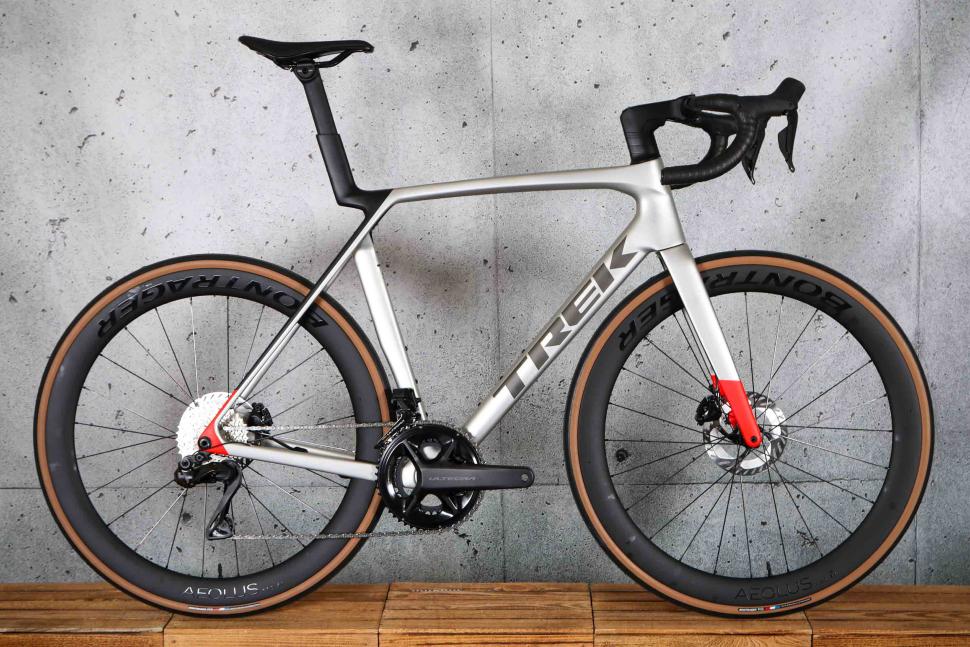 2025 Trek Madone Gen 8 SL 7
2025 Trek Madone Gen 8 SL 7Trek unveils radically updated, lightweight Madone and ditches the Émonda. Here’s why we think it's the biggest bike launch of the year so far
Trek has merged its two top-end road platforms with the release of its Madone Gen 8 road bike which is said to be as aerodynamically efficient as the previous Madone and as light as the existing Émonda SLR. For those of you filling in your bike launch bingo cards, Trek also says that its updated IsoFlow technology – with a hole in the seat tube and a cantilevered seat mast – is 80% more vertically compliant than before to smooth the ride. There are SLR and SL versions, and it's the SL we've got our hands on that you see in the main image above.
“With a new Gen 8 Madone, you really don’t need two race bikes anymore,” says Trek’s director of road bikes Jordan Roessingh. “It provides that snappiness and lightweight ride of the Émonda, but still provides that feeling of speed that you can only get on the Madone, and encapsulates that into one single bike platform.
“If you’re an Émonda rider, you’re getting a much, much faster bike with the new Madone, but it’s the same weight. You get a bike that’s much, much lighter than the seventh-generation Madone, but with the same aerodynamics.
“It’s the concept of no compromises that finally achieved the goal of merging those two platforms into one. Every rider, whether you’re a professional or you’re just simply doing the Sunday group ride, will benefit from the new platform because it’s the best of both worlds.”
Here are Trek’s key claims for the Madone Gen 8 in a handy cut-out-and-keep bullet point format:
- The top-level SLR is as light as the current Émonda SLR frameset and 320g lighter than the seventh-generation Madone SLR frameset thanks to redesigned tubes and the use of new 900 Series OCLV Carbon
- The Madone Gen 8 replaces both the seventh-generation Madone and the carbon Émondas (the alloy Émonda ALR will remain in the range)
- It’s 77 seconds per hour faster than Émonda and as fast as the previous Madone (as a complete system comprising bike, rider, bottles and cages) at 200 watts
- The Madone Gen 8 uses what Trek calls Full System Foil aero shapes which are considerably shallower and lighter than those used for the seventh-generation Madone frameset
- The updated IsoFlow technology is lighter than previously and 80% more vertically compliant to absorb road chatter
- Top-level Madone SLR models come with an updated Aero RSL Road integrated handlebar and stem that’s lighter and “more ergonomic” than previously
- The eighth-generation Madone SL shares top-level SLR’s frame design, but it’s made with 500 Series OCLV Carbon and the handlebar and stem are separate units
We’ve seen the Madone Gen 8 loads over the past few weeks after it was leaked online and then ridden by the Lidl-Trek team. Mads Pedersen won Stage 1 of the Critérium du Dauphiné on the new bike on the first day it was raced.
> New Trek Madone breaks cover at Dauphiné… or is it an Emonda?
Why do we say this is the biggest bike launch of the year? Trek is a massive worldwide brand and merging its two best-known road bikes is a huge step. Plus, the fact that Trek has joined the likes of Specialized and Pinarello in offering a single top-end road race platform makes it even more likely that other brands will follow suit. If you disagree, let us know why in the comments.
Trek merges the Madone and Émonda platforms
There was a whole lot of debate about the identity of the new bike in the run-up to this launch; would it be an Émonda (the lightweight option in Trek’s range), a Madone (the aero one), or an entirely new model? It was a lot of fun for a while back there, and it turns out that the discussion was justified.
Development work started on a new Émonda but the design morphed into a Madone along the way – hence the release of this eighth-generation model just two years after the previous version was launched.
“One of the things that repeatedly came up whenever we talked to the Lidl Trek team riders about the Madone or the Émonda was that they would stress over which bike was right for them, specific to their job on the team, or for the course,” says Jordan Roessingh.
“One thing that fed into the development of this bike was the feedback that we got from them. For us, this new Madone delivers on an expectation from them to race the best bike in the world. The concept of a single race bike has been out there for a while, and one of the reasons we haven’t done it previously was that it required too much compromise. We started the R&D [research and development] process for this bike and it was originally intended to be the next generation of Émonda.
“We were trying to reduce the weight of that bike while keeping the aerodynamic benefits. We had just got back from our first wind tunnel trip, and we were starting to get our initial structural analysis results in as well.
“We figured out that we could make this really super-lightweight bike, but also with aerodynamics that were approaching the performance of the current Madone. We got through a couple of prototypes, modelling, wind tunnel trips, some structural analysis, and we realised there was an opportunity to make something completely new.
“We were our own biggest critics of the concept. The scepticism was about whether or not we’d be able to execute this no-compromises concept.
Lead engineer Alex Loy takes up the story.
He says, “We drew a plot on the whiteboard, weight versus aerodynamics, and we put a big X on there and said, ‘this is our BHAG [big hairy audacious goal; a major target, essentially]’. The only way the bike would truly be successful for all of the riders on both of our platforms today is if it could perform the same as an Émonda and the same as a Madone. We designed many different prototypes. Every couple of months we’d get a little bit closer.”
Jordan Roessingh says, “It was only halfway through the development process that we finally gained confidence in the idea that the best of both worlds without compromises was a reality – the opportunity to have one bike that can do it all, that exceeds in every environment. It quickly morphed through that development process into becoming the next generation of the Madone.”
The story behind Trek’s new tube profiles
Among the most important features of the Madone Gen 8 are tube shapes, which are radically different from previously.
“We’re calling them the Full System Foil shapes,” says aerodynamic lead John Davis. “The previous generation used old-style Kammtail aero shapes where we tried to get as deep an airfoil as possible, thinking of the tube shapes like airplane wings. You take a deep airfoil, you cut off the back, and that’s a Kammtail.
“But now we have updated the simulation methods, and we can get the same performance as a deep airfoil in a much more compact, lightweight shape. We have cutting-edge optimisation techniques and we have a computer generate thousands of different shapes. We get a book of aero and lightweight shapes that we can choose from.
“We look through these shapes and select the one that works best for a particular area, and we build up many different prototypes to see what works and what doesn’t.”
Trek says that simply selecting the shapes that are most aerodynamically efficient might produce a frame that performs well on its own in the wind tunnel, but it might not be as impressive when built up into a complete bike. For that reason, the designers say they included shapes that work best with the areas in front and behind them to get the fastest possible complete system.
“You’ve got the down tube, the two aero bottles, and then the seat tube. We took that slice and we designed all those shapes to work together to design one large airfoil,” says John Davis. “That way we can get the aero benefits of a really deep airfoil, but we don’t have to have a huge section of carbon fibre that’s going to be heavy.
“We’ve designed the fork to be a nice aero-shape. The legs are the draggiest, slowest part of the full system, so anything you can do to slow down or move the air around the legs is important.
“Other parts of the bike don’t look like traditional aero shapes. An example would be the down tube which is shaped with a pretty blunt front end because it’s behind the wheel, which slows down the flow, so the leading edge doesn’t matter as much. Then the sides are shaped to direct the flow around the down tube bottle, and then move around the seat tube bottle, and finally onto the seat tube itself.
“After the rider’s legs, there is slow-moving, low-energy flow, and you want to add speed and energy to that flow. That’s why we have IsoFlow with a gap to allow energy to get back into that slow-moving region, and why we have very fast aero shapes on the seat tube and the seatpost to make sure we’re not sucking energy out of that crucial region.”
According to Trek, Madone Gen 8 has less drag than the Émonda at all yaw angles, and less drag than the seventh-generation Madone at the low yaw angles most commonly encountered by riders.
If you’re interested in more details, Trek has published a whole white paper on the Madone Gen 8’s aerodynamics.
New RSL bottles and cages designed to improve aero performance
The Madone SLR comes with its own RSL bottles and cages that are designed to improve the bike’s overall aero performance. The Madone SL doesn’t have these as original equipment, but they can be added later.
“We took the optimisation techniques that we used for the Full System Foil and applied it to the aero bottles and the down tube and seat tube shapes on either end to give your maximum gains on the Gen 8 Madone,” says John Davis.
The bottles fit flush with the carbon RSL Aero Cages, which can also take standard round bottles. The cages use a low-profile button-head bolt and are mounted via slots. These slots allow you to move the cages up and down to achieve the most aero position. Trek says that minimising the gaps between the frame and bottles maximises aerodynamic efficiency.
Although designed to work specifically with the tube shapes of the Madone Gen 8, the bottles/cages can be mounted to most bikes that take a standard round cage.
“We tested the aero bottles on a lot of other bikes, and we saw gains on every single one,” says John Davis.
Madone SLR gets a lighter one-piece RSL Aero handlebar/stem
The top-level Madone SLR also gets a new one-piece RSL Aero bar/stem that has been designed with the Full System Foil aero shapes. Trek says it drops weight over the previous model while improving ergonomics.
“We’ve designed the new bar/stem to be lightweight and aero and also comfortable to ride,” says John Davis. “That usually requires a trade-off because an aero shape by itself is going to be deep and heavy and it’s not going to be as comfortable when your hands are on the tops, but we came up with a new shape.
“We took the aero shape and widened it, and that helps the structural efficiency, helps to make the shape lighter and more comfortable in your hands. That would usually hurt drag, but since it’s in front of the legs, it conditions the flow and actually reduces the drag of the full system, because we’re reducing the speed of the air hitting your legs.”
The bar/stem uses the same drop shape as with the seventh-generation Madone, with a hand position that’s 3cm narrower on the hoods than on the drops. The idea is that you get a wide, stable stance when you’re down in the drops, and an aero advantage when you’re on the hoods.
Trek has introduced a new high-end frame material
Trek has introduced a new grade of carbon fibre, which it calls 900 Series OCLV, for the top-level Madone SLR. OCLV stands for Optimum Compaction Low Void and it’s the name that Trek has given to various kinds of carbon for years, but 800 Series has been the highest grade until now.
Trek says that 900 OCLV is “up to 20% stronger” than its previous top-tier carbon, so it can use overall material and make its lightest-ever carbon laminate.
“The carbon-fibre material is more efficient at achieving our structural and weight needs,” says lead engineer Alex Loy. “Then [we can further improve the frame through] manufacturing processes, including using an inflatable mandrel to improve compaction in the carbon fibre and allow for a much cleaner interior to the tubes themselves, which means fewer wrinkles and less need for additional structural material.”
Trek claims a frame weight of 796g for the Madone SLR Gen 8 (size ML, no hardware), and 350g for the fork.
The Madone SL is made from existing 500 Series OCLV carbon fibre.
New IsoFlow design offers 80% more vertical compliance, says Trek
Ah, good ol’ vertical compliance. It wouldn’t be a proper bike launch without a mention. Trek says that its IsoFlow design is now lighter and more compliant than on the Gen 7 Madone and that the bike is 24% more compliant than the Émonda.
“The very first part of this project was to determine whether IsoFlow was going to carry on to this generation, so we spent three or four months iterating on different models and different concepts, pushing the boundaries of UCI legality on completely different top tube to seat tube to seatstay junctions,” says Alex Loy.
“Drop stays perform really well, but they wouldn’t provide the combination of ride quality and weight savings we were looking for. We looked at three parameters: weight, aerodynamic impact, and comfort. The combination of those can be tricky. We looked at larger IsoFlow holes, smaller IsoFlow holes, and different locations. We also looked at different lead-ins and exits for the surfacing around it.
“As a result of what we were able to change from the previous version, we’re able to have 80% more vertical compliance at no cost to aerodynamics or weight. We reduced the size of the IsoFlow hole a little bit and changed the aerodynamic shaping that goes through the hole to optimise the airflow.”
Madones come fitted with 28mm tyres but you now fit up to 32mm (as measured) if you want to put more air between yourself and the road. The Madone SL 6 and upwards are tubeless-ready.
Madone Gen 8 shifts to ’Road Race’ geometry
Compare the Madone Gen 8’s geometry chart with the previous version and it looks like everything has changed, but it’s not as if Trek has radically altered its approach here.
First, the Madone’s geometry is now called Road Race rather than H1.5. Why? H1.5 originally came between Trek’s H1 and H2 geometries, and neither of these exists anymore. Plus, Trek feels that Road Race is a whole lot more descriptive.
Trek has also shifted from eight frame sizes down to six. Why? Although Trek doesn’t give it as a reason, we know that the company is driving down stock-keeping units (SKUs) to reduce costs. https://road.cc/content/tech-news/what-treks-rightsizing-plans-mean-bike.... Going to six sizes means tweaking things to cover a similar range.
The 52cm and 54cm sizes have been combined into one medium size and the 62cm model has been replaced by an XL with a taller seat mast.
“When we were making the new Road Race geometry, we wanted to make sure we were fitting a realistic race population, so we took real data from our Precision Fit system https://trekbikes.com/gb/en_GB/precision_fit_retail/, and then our in-house data analyst expanded that dataset,” says mechanical design engineer Christie Sorenson. “The new geometry is within millimetres of our old one, and riders shouldn’t notice a difference.
The Madone now also comes with size-specific tube shapes designed to provide the right level of compliance and reduce the weight for smaller riders.
“We now have a second tube shape that we use for the lower half of our size range,” says Christie Sorenson. “With this range, we are getting lighter bikes at the smaller sizes because we're designing specifically for those smaller sizes.
“This time around we were able to bring two bikes to the wind tunnel and test both to make sure that we were getting the benefits, the speed and the quickness that we're seeing on the top end in the small sizes when we’re scaling down.
“The big sizes are still optimised – they’re still getting the best that we can produce in aerodynamic, stiffness weight. Now we’ve made sure of that across the whole size range.”
The small stuff
Trek says it has made a big effort towards standardising components across its family of road bikes, and that continues with the new Madone.
“This started with the T47 [threaded] bottom bracket system that’s used on all Trek road platforms, and with the Gen 8 Madone that’s extended with the inclusion of UDH (Universal Derailleur Hanger) and the new RCS Headset System,” says Jordan Roessingh.
RCS Headset System? It aims to standardise the parts needed across different platforms and models.
Trek says, “Starting with Madone SLR/SL Gen 8, the new RCS Headset System simplifies and standardises the parts needed to cover cockpit setups across models and between platforms.”
“Trek road frames made for the RCS Headset System will use a consistent headset bearing cover and spacers depending on stem type [RCS Race is designed for use with the new RSL Aero bar/stem found on the Madone SLR Gen 8; RCS Pro is for use with the RCS Pro Blendr stem included on the Madone SL Gen 8; RCS Universal is for use with traditional round stems], so you’ll always know exactly what parts are needed to swap cockpits between models/platforms.”
Again, this will also help Trek reduce its SKUs.
How do the Madone SLR and the Madone SL differ?
The main difference between the two new Madone platforms is that the top-level SLR is made from Trek’s new 900 Series OCLV carbon fibre (see above) while the SL uses the existing 500 Series OCLV. This makes a difference to the weight, Trek quoting 796g for the Madone SLR’s frame (size ML, no hardware) and 350g for the fork, whereas the equivalent figures for the Madone SL are 1,054g and 363g respectively.
The Madone SLRs also come with Trek’s updated one-piece carbon-fibre handlebar/stem (see above) whereas the Madone SLs come with separate handlebars and stems. Trek says the Madone SL’s bars share a similar shape and flare to those of the Madone SLR cockpits, and all SLs use the same RCS integrated stem (which takes any 31.8mm diameter bar).
The SL is compatible with mechanical drivetrains whose front derailleurs have a housing stop whereas SLRs take electronic drivetrains exclusively because there’s no exit port for front derailleur housing on the down tube.
Trek argues that the Gen 8 Madone SL is a better-performing road bike than its seventh-generation SLR, offering a similar level of aerodynamics while being lighter.
Weights, builds and prices
Trek lists these weights for the Madone SLR:
Frame: 796g
Fork: 350g
Trek lists these weights for the Madone SL:
Frame: 1,054g
Fork: 363g
...and here are the various build options with prices:
Madone SLR 9 AXS (£12,500)
Groupset: SRAM Red AXS (inc power meter)
Wheels: Bontrager Aeolus RSL 51
Claimed weight: 7.00kg
Madone SLR 9 (£12,000)
Groupset: Shimano Dura-Ac e Di2
Wheels: Bontrager Aeolus RSL 51
Claimed weight: 7.05kg
Madone SLR 7 AXS (£8,500)
Groupset: SRAM Force AXS (inc power meter)
Wheels: Bontrager Aeolus Pro 51
Claimed weight: 7.43kg
Madone SLR 7 (£8,000)
Groupset: Shimano Ultegra Di2
Wheels: Bontrager Aeolus Pro 51
Claimed weight: 7.31kg
Madone SL 7 (£6,000)
Groupset: Shimano Ultegra Di2
Wheels: Bontrager Aeolus Pro 51
Claimed weight: 7.88kg
Madone SL 6 AXS (£4,750)
Groupset: SRAM Rival eTap AXS (inc power meter)
Wheels: Bontrager Aeolus Elite 35
Claimed weight: 8.43kg
Madone SL 6 (£4,250)
Groupset: Shimano 105 Di2
Wheels: Bontrager Aeolus Elite 35
Claimed weight: 8.16kg
Madone SL 5 (£3,250)
Groupset: Shimano 105 mechanical
Wheels: Bontrager Paradigm SL
Claimed weight: 8.70kg
A Madone SLR frameset is £4,575 and a Madone SL frameset is £2,750.
The Madone SLR is also available through Trek’s Project One custom programme, where you can choose the finish and the build.
Mat has been in cycling media since 1996, on titles including BikeRadar, Total Bike, Total Mountain Bike, What Mountain Bike and Mountain Biking UK, and he has been editor of 220 Triathlon and Cycling Plus. Mat has been road.cc technical editor for over a decade, testing bikes, fettling the latest kit, and trying out the most up-to-the-minute clothing. He has won his category in Ironman UK 70.3 and finished on the podium in both marathons he has run. Mat is a Cambridge graduate who did a post-grad in magazine journalism, and he is a winner of the Cycling Media Award for Specialist Online Writer. Now over 50, he's riding road and gravel bikes most days for fun and fitness rather than training for competitions.
Latest Comments
- brooksby 10 min 39 sec ago
There are comments on the Bristol Post about this along the lines of how pedestrians only ever have to wait a few seconds so why change anything....
- brooksby 12 min 23 sec ago
"A few decades down the line" our civilisation will have likely collapsed… But at least there will be plenty of space to park your Mad Max styled...
- parcours 30 min 53 sec ago
Anything is possible with a custom build. We do a reasonable number of track builds each year & can offer it on any road model in the line-up
- Condor Andy 38 min 8 sec ago
Velogames' Spring Classics comp is open and is more in tune with the road.cc game. You have 24 transfers to use between MSR and LBL. There are also...
- chrisonabike 34 min 27 sec ago
Yup - while I'm normally "more bollards" this needs nuance....
- NPlus1Bikelights 1 hour 10 min ago
Mildly interested. My knees don't like the rotations needed for unclipping, I use well made Japanse MKS half clips on a commuter bike. They do...
- Born_peddling 1 hour 34 min ago
Was just about to say UCI corrupt? Never! 🤣
- Miller 1 hour 34 min ago
Sounds great but worth noting that the Osmo Action 4 can be had for £189 at the moment.
- hawkinspeter 1 hour 36 min ago
Campaigners condemn Liveable Neighbourhood vandalism:...
- Pink Duck 1 hour 50 min ago
The Cyclists Dismount signage is now up, not that anyone pays any attention to it.

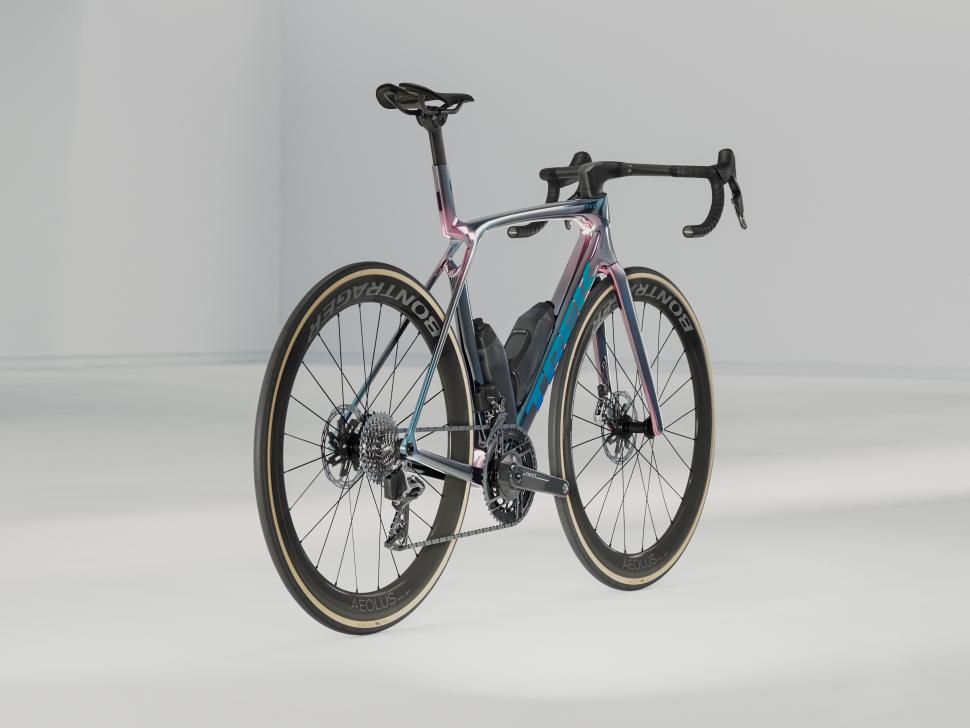
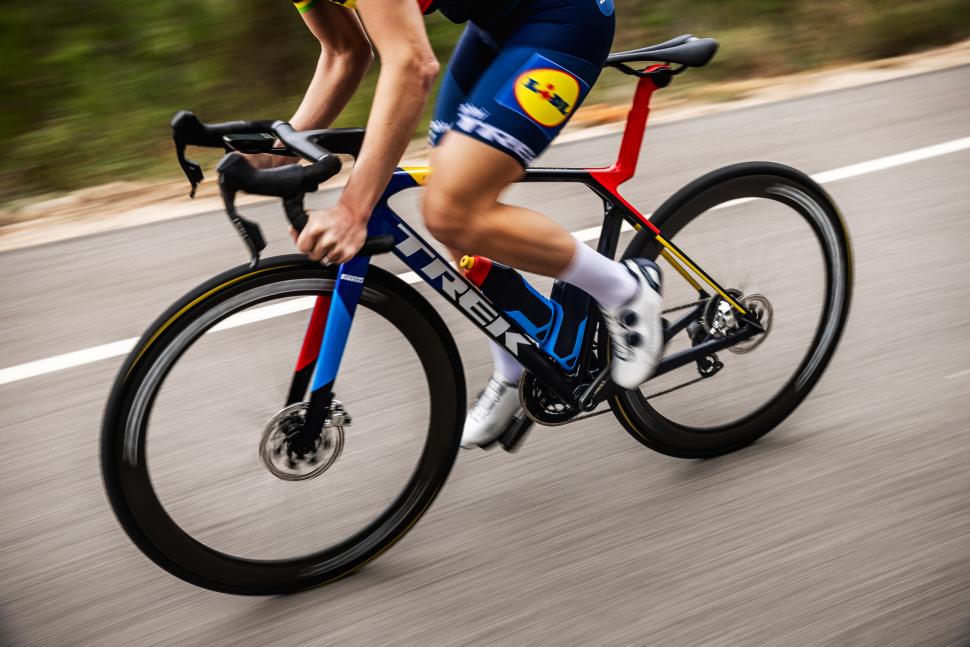

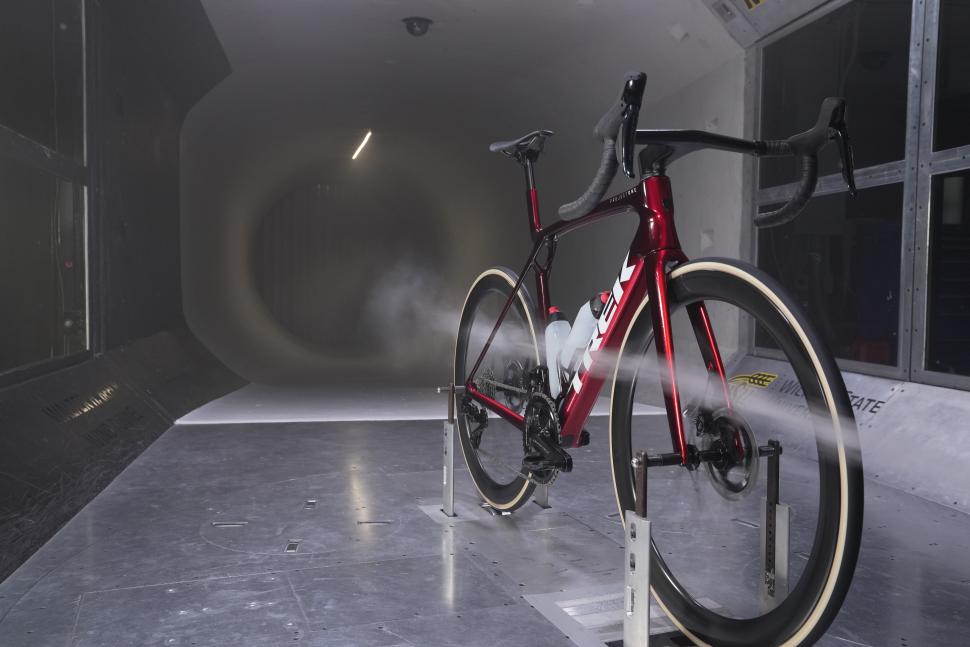
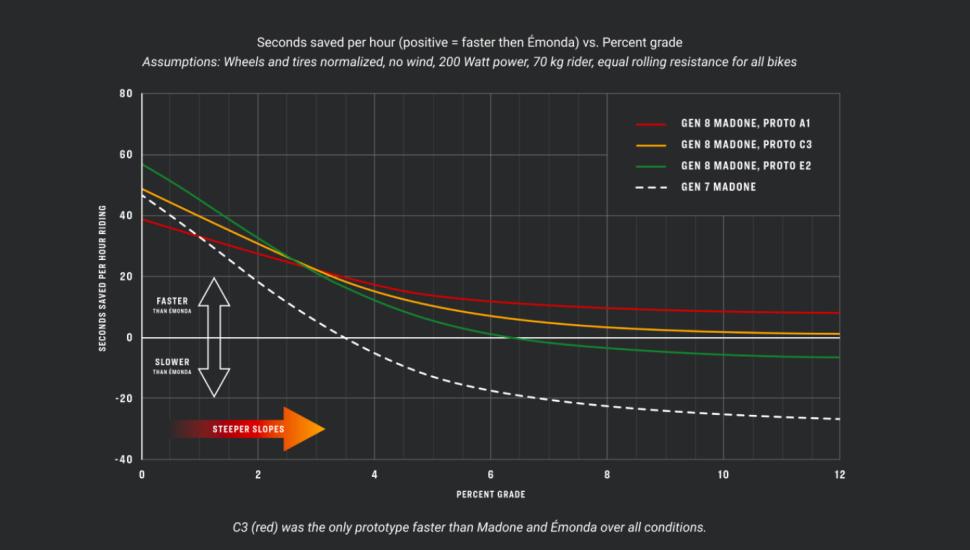

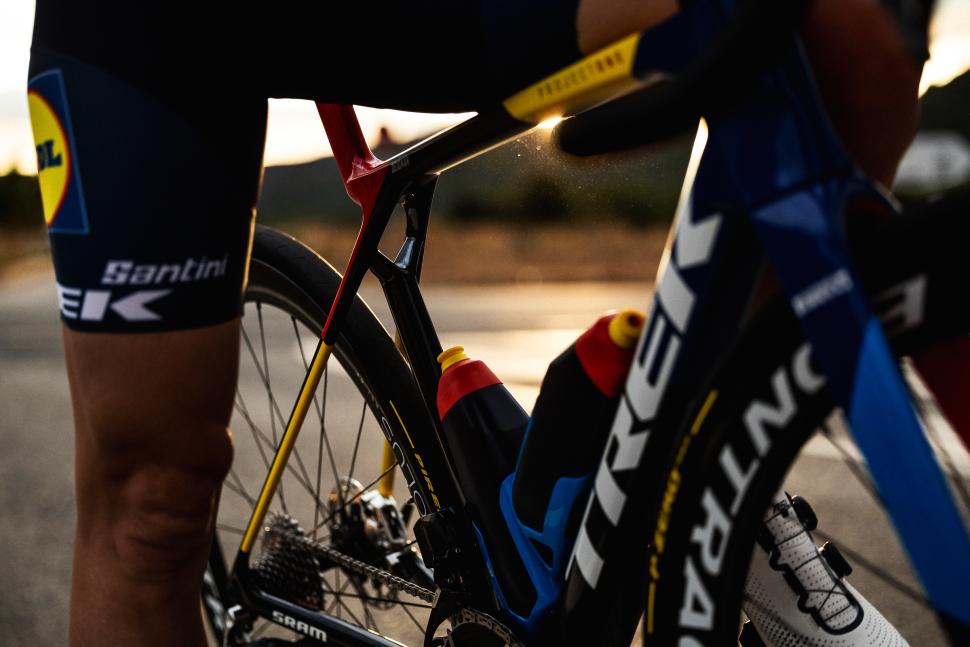

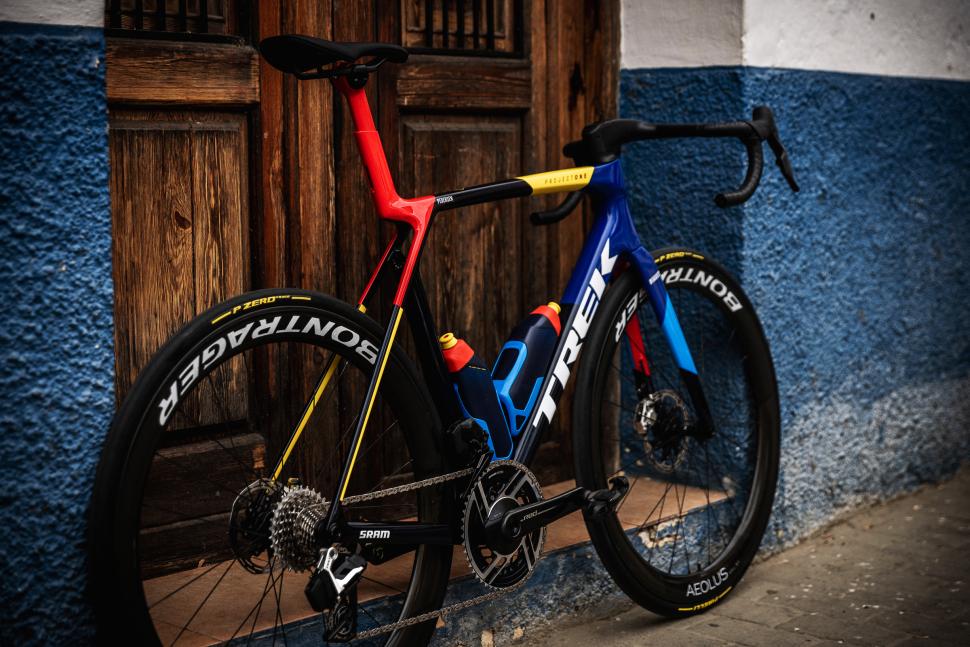
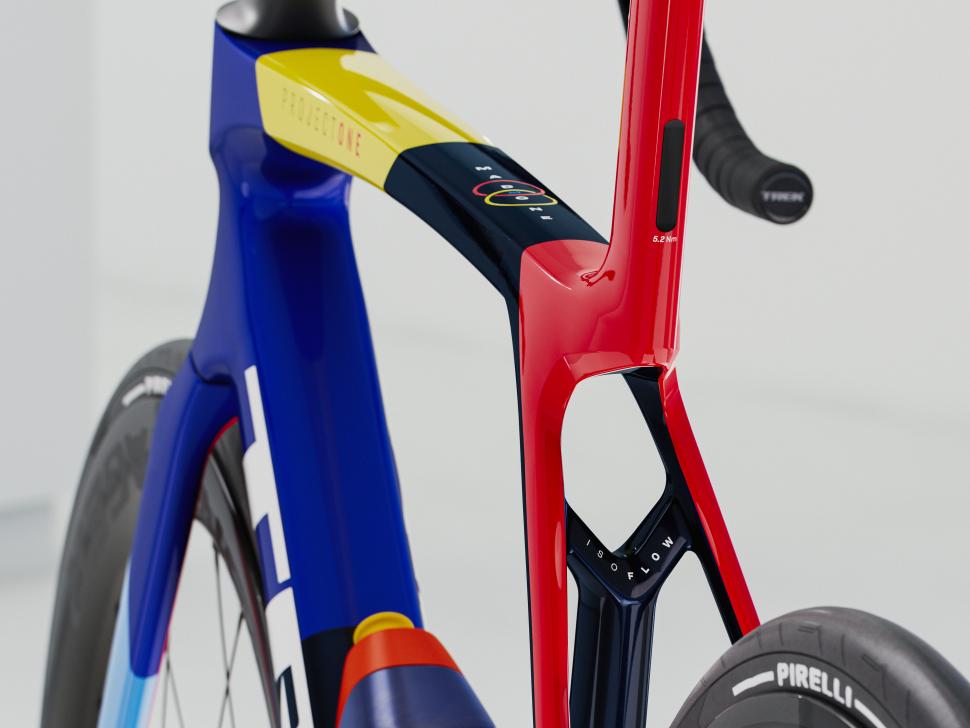
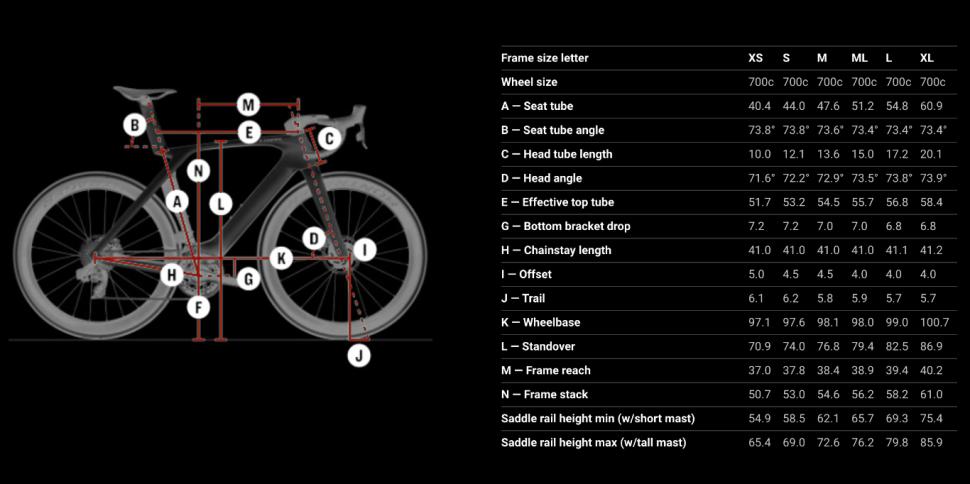
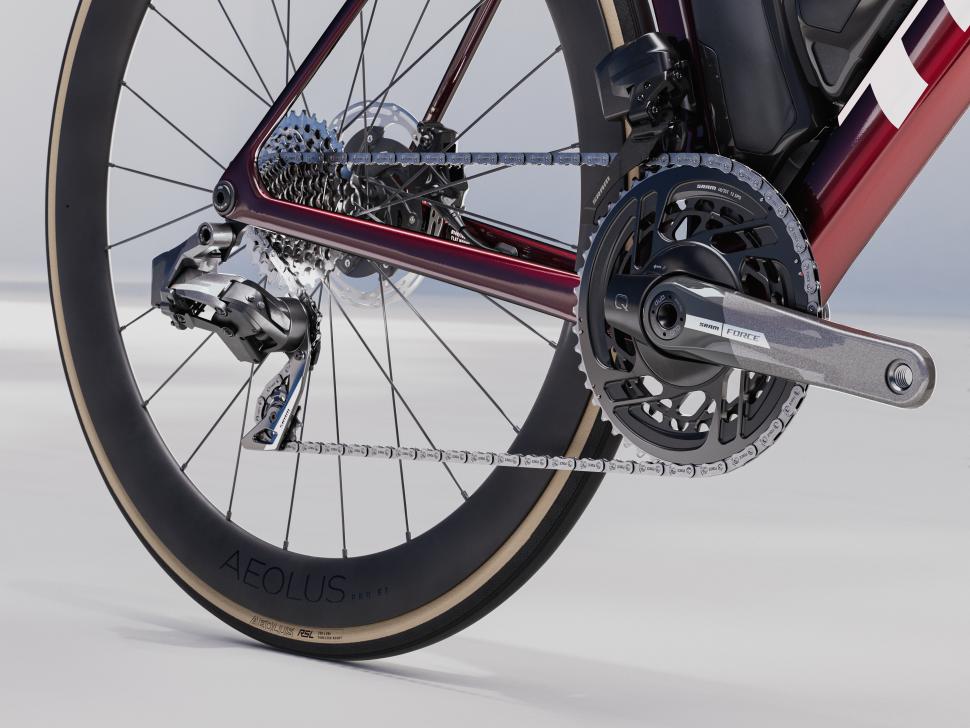

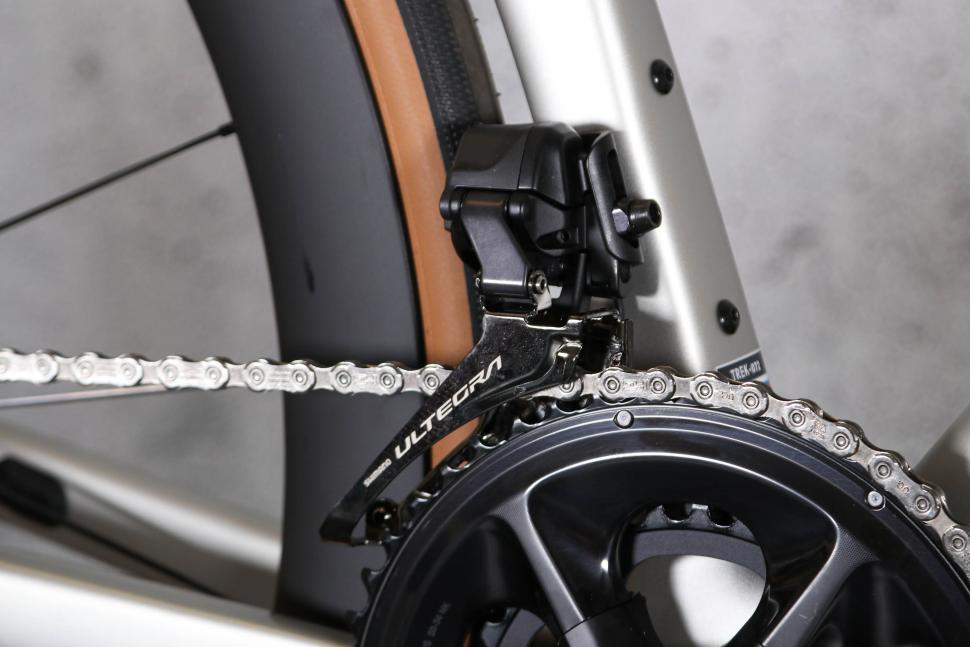

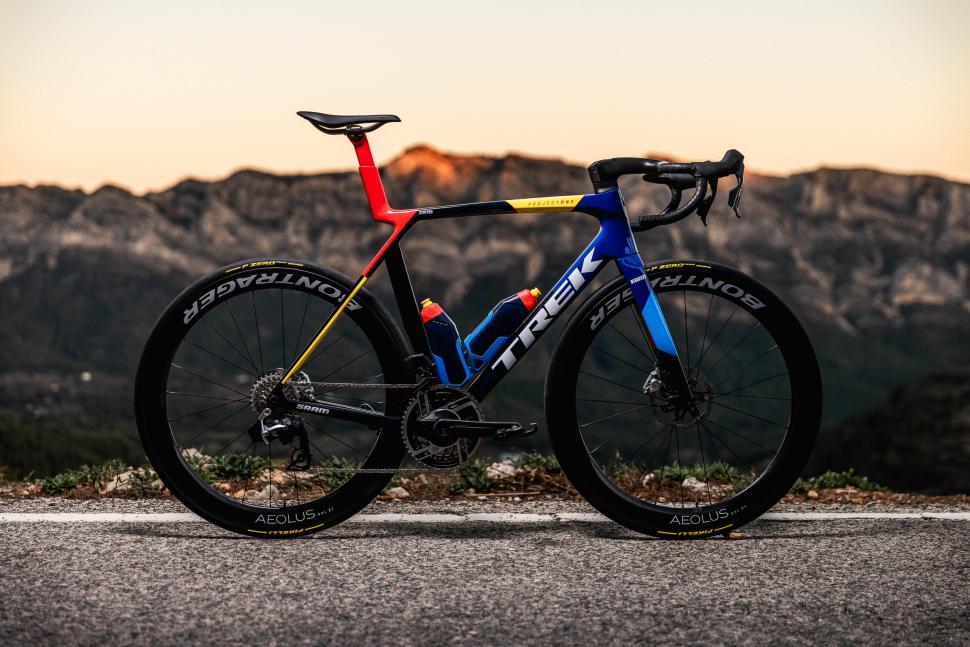
Add new comment
24 comments
Back to the 20teenies then with a "one Madone to rule them all". Looks like a lovely bike, I fully approve, but if combining 52cm and 54cm frame means something in between, then that'll be too small for me. I've 2014 and 2021 54cm Madones just right for me and I'm average height (5'9"). Seems an odd choice of sizes to merge.
wire bead tyres and heavy wheels on this one so as not to embarrass the more expensive bikes with a cheaper bike weighing less - "Madone SL 5 (£3,250)
Groupset: Shimano 105 mechanical
Wheels: Bontrager Paradigm SL
Claimed weight: 8.70kg"
Can't decide who's the mug - them for not realising sooner that one bike could be simultaneously as light and aero as their two specialist models, or us for believing them. Something about that Lidl team paint job pleases my inner child though.
Part of me thinks it looks pretty cool, somewhat reminiscent of the Looks ridden by Lemond and Hinault in the '80s, but another part of me thinks why would I want to cycle around on a big advert for a supermarket chain having paid £12,000 for the privilege?
It's academic because I'm not going to buy one (even if the team livery is available to Joe Public) but I think I could tolerate it because it doesn't look like it actually says Lidl anywhere, just pleasing bold colours. However, if I ever win the lottery to be in a position to spend this on a bike, I'll be taking it for full custom paint from Fat Creations (drool emoji)
Well isn't that what Specialized did with the tarmac? 1 bike to rule them all - bye bye Venge.
then they released the Aethos!
so what's all that about?
£500 difference between the frame only and 105 model is bonkers! And only 250g difference in frame weight between SL and SLR.
So basically buy the 105 model dump the components and wheels and spend about £1000 on upgrades and you probably end up with an SLR killer that comes very close to its weight but for about £4k.
that seat tube is making me twitchy about the time to warranty claim!
All largely irrelevant for the majority of cyclists - unless you're a high level racer. The cycling industry/media in the UK are far too focussed on the performance/ racing sector.....
I'd say that the biggest bike company in the world launching a new top-end (and "cheaper" versions) bike is the sort of thing a publication aimed at cycling fans and recreational cyclists would be expected to cover. There's perhaps more racing stuff than usual, but the Tour's about to start and many readers are interested. Much as I'm sure it disappoints road.cc, the majority of cyclists don't read or view any cycling media.
I'm not interested in the travails of Halfords because I don't shop there, and there are lots of reviews of commuter-type things that I wouldn't buy. If I'm especially not-interested in a product or topic, I might even just not read about it on the understanding that not everything is tailored to my interests.
Not sure I agree - the lower end models are well within the budget of an average road.cc reading and the aero benefits at low wattage of 200 was a nice touch.
Lots of people would find the sales pitch attractive even if the aero gains are to be taken with a pinch of salt.
Yes, definitely relevant to club riders and weekend warriors (me). My 2014 Madone gave me about an extra 1/2 mph average over 50-80 miles and more on short club pub rides (20ish mph). 2021 Madone about the same again and the IsoSpeed makes it properly comfy too.
The top-end stuff works by association or reputation. Just like car and motorbike manufacturers spend many millions on racing a vehicle with their name on it, even though it bears no similarity to the ones on the forecourt, because they know it works. "Win on Sunday, sell on Monday".
Like Rendell, I really like the colourscheme from the moment I saw the photos from the Dauphine. And I agree it is reminiscent of the La Vie Claire team colours (also echoed in the Look 795 RS). But I think the IsoFlow thing looks a bit gimmicky.
It must be one of the ugliest at any rate.
77 seconds per hour faster????
It was good to see the figures quoted for a wattage figure, and even one that (some) people spending their own money on it might be able to do. The usual X watts saved over an hour at 45kph probably isn't very relevant to the target market.
thought exactly the same - savings at 200w is somethign i can do regularly rather than 45km/h so if this is all aimed at marketing to amateurs - the pros have no choice - then i'm surprised more brands dont use this metric.
I'm struggling with this - does this mean my life will be longer or shorter as a result of riding it?🤔🤪
Your life will be the same length, but you'll experience everyone else around you aging at a different rate due to your relative speed difference.
Road Race Geometry means whopping great head tube does it, that's mental for a race bike
I have a 'special edition' white paint job like that on my bike too.
Oh wait........no!
Makes Giant's decision - to maintain both the tcr & Propel models - a bit puzzling
Get rid of the TCR? Sacrilege.
Cervelo stick firmly with the R5 & S5 and Visma-Leaseabike (TJV. Etc) seems to do pretty well.
Scott still have an Addict and Foil
Cannondale still do a supersix and systemsix.
there is no one way that is best. Mostly it's down to money. If you only make 1 frame of varying standards it's cheaper than 2-3 different bikes. They will give all these fantastic figures yet I've read a lot of reviews that question given stats like weight or real world aero benefits and it should be taken with a pinch of salt.